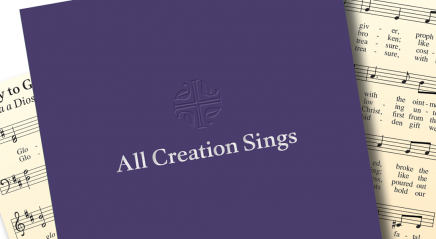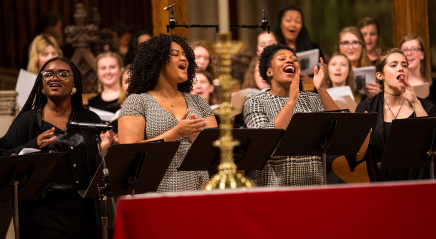Author’s note: Lutherans and other hymn lovers may be surprised to learn how many of their favorite hymns come from medieval texts. Can anything good come out of the “Dark Ages”? Martin Luther thought so; he adopted and adapted multiple hymn texts from the Middle Ages, both Latin and German. This is the second in a four-part series exploring examples of pre-Reformation hymn texts in their historical contexts and sequence.
Multiple hymns overflowing with love for Christ and him crucified have been attributed to the 12th-century French abbot Bernard of Clairvaux (1090-1153), most famously “O Sacred Head, Now Wounded” (Evangelical Lutheran Worship, 351-52).
Even in the momentous century of the Crusades and Gothic cathedrals, Bernard could be called the “big dog” of his time, though the Swiss name for those large canines comes from a different Bernard. The abbot of Clairvaux mentored the popes who had been his novices, advised such royals as Louis VII and Eleanor of Aquitaine, defended traditional biblical theology against new speculations, and encouraged Hildegard of Bingen to write down her thoughts and spiritual experiences. (The Benedictine abbess near the Rhine, a visionary genius in several fields, wrote multiple books and dozens of songs, though the latter were intended for skilled soloists, not congregational singing.)
Bernard’s main theme was love, whether in sermons on the Song of Songs or in essays such as “On Loving God.” His fervent focus on Christ, the cross, grace and forgiveness received appreciative testimonials from Martin Luther and in the Lutheran Confessions.
Bernard’s faith and fame led followers to attach his name to later writings that sounded his themes. A long 12th-century poem from his monastic context was later attributed to him and still later translated into several familiar hymns. “Dulcis Jesu Memoria” means the “sweet memory of Jesus,” as preserved in “O Jesus, Joy of Loving Hearts” (ELW, 658) and “Jesus, the Very Thought of You” (ELW, 754). Whether Bernard wrote this poem or not, it overlaps with his known works. From “On Loving God”: “O Lord, you are so good to the soul who seeks you, what must you be to the one who finds you?” From “Jesus, the Very Thought of Thee” in Edward Caswall’s fuller translation (Service Book and Hymnal, 481): “How good [thou art] to those who seek! But what to those who find?”
“Thy grief and bitter passion were all for sinners’ gain; mine, mine was the transgression, but thine the deadly pain.”
Another poem has enjoyed an even longer afterlife in hymnody, including creative arrangements by Johann Sebastian Bach. The poet evokes the visual field of a crucifix, contemplating several parts of the Savior’s crucified body such as the hands and, especially, the face. The oldest manuscript credits a later abbot, Arnulf of Louvain (ca. 1200-1250), but the sentiments convey Bernard’s message. The section on the hands was loosely paraphrased by Charles Porterfield Krauth, the first professor of systematic theology at the Lutheran Theological Seminary at Philadelphia: “Wide open are your hands to pay with more than gold. The awful debt of guilt and sin, forever and of old” (Lutheran Book of Worship, 489).
“O Sacred Head” connects a German Lutheran to an American Presbyterian. Paul Gerhardt (1607-1676), a pastor-poet beloved for his own hymn texts, translated the entire medieval poem, including the 10 verses on the “head full of blood and wounds.” Bach used this text in cantatas, oratorios and, especially, the “St. Matthew Passion.”
It also inspired James Waddel Alexander (1804-1859), a New York pastor and a professor at Princeton (N.J.) University, to translate the German text into English, again all 10 verses.
O sacred head, now wounded, with grief and shame weighed down, now scornfully surrounded with thorns, thine only crown.
Modern hymnals have steadily reduced the number of verses printed. The few that remain still convey much of the original power, but the translations have toned down the bloody details. The beatings, the blood and the spit have been cleaned up, yet the meaning of Christ’s passion remains. The medieval poem’s personal application, “killed this way because of me, a sinner of indignity,” became Gerhardt’s penance—“I myself bear the blame for all that you have borne”—as followed by Alexander, and thus our own confession as we sing in verse 2:
Thy grief and bitter passion were all for sinners’ gain; mine, mine was the transgression, but thine the deadly pain (ELW, 351).
Hans Hassler’s tune, taken fittingly from a love song, was paired with several hymn texts before Gerhardt’s, but Bach’s genius secured this match for all time.
Gerhardt and Alexander both took poetic license with the medieval text, as poets should. But the version we sing today gives the last word to Abbot Bernard himself, on the very theme that Luther appreciated:
These eyes, new faith receiving, from thee shall never move; for all who die believing die safely in thy love.
Next: The September/October installment in this series will examine the canticle of St. Francis of Assisi, “All Creatures.”









